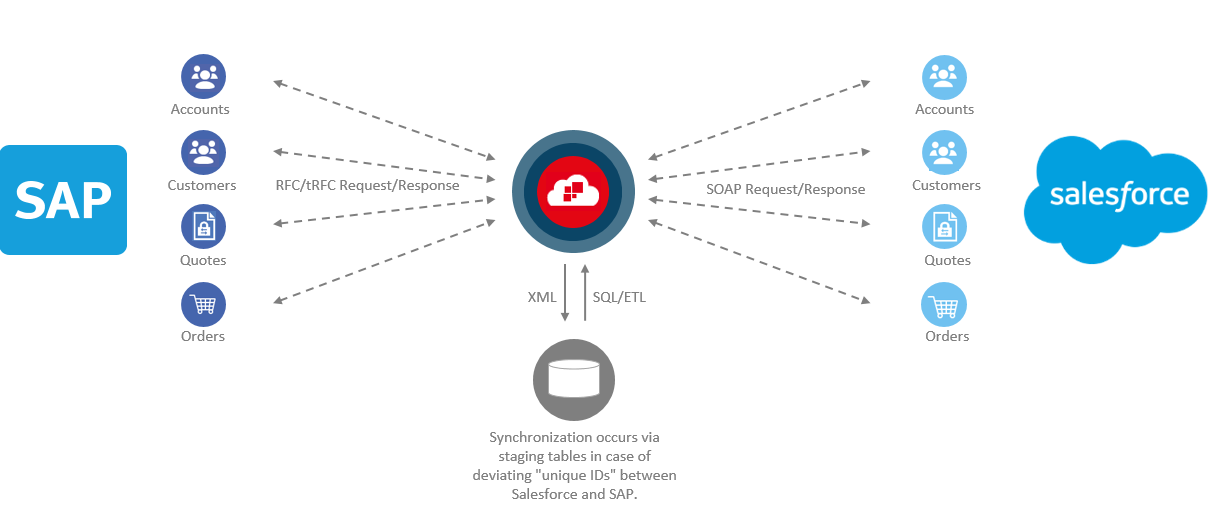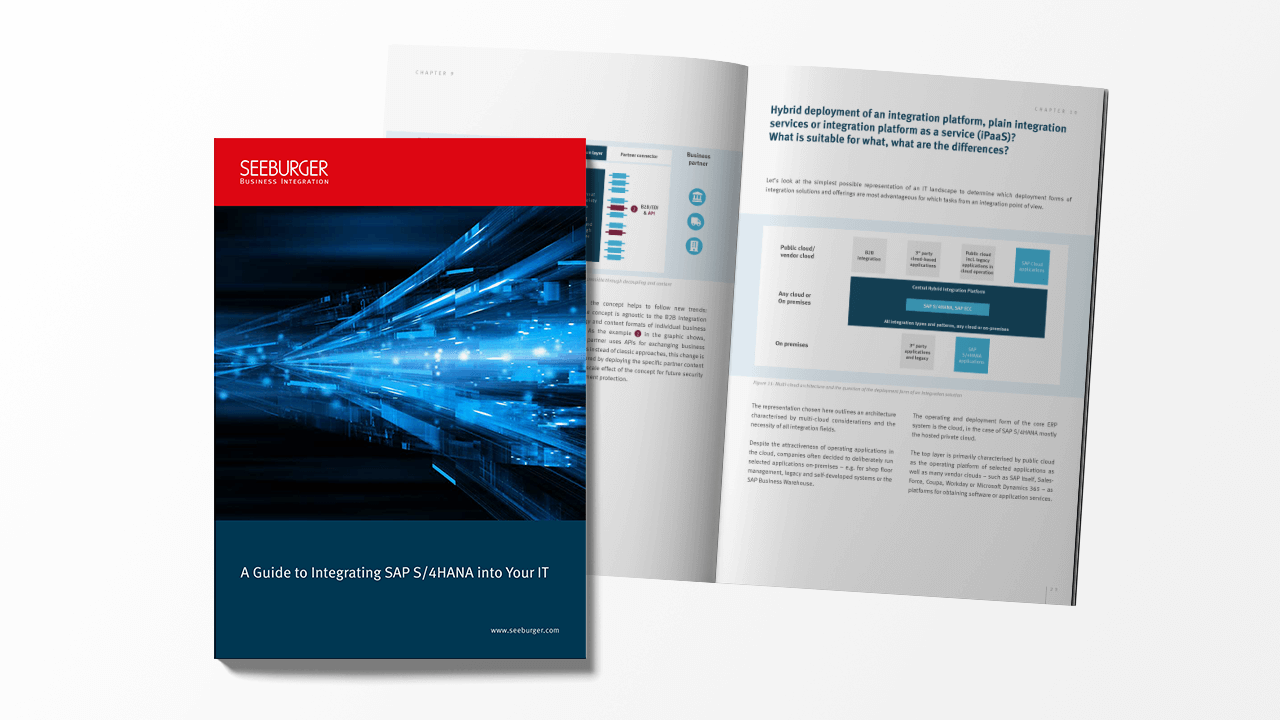
Salesforce API Integration in SAP: Avoid Proliferation of Interfaces
Bridge the communication gap between your enterprise applications
Salesforce Integration in SAP
To combine the two market-leading applications that are Salesforce and SAP is one of the most common real-time API integration scenarios. Accordingly, there is a wealth of solutions – among others also by the providers Salesforce and SAP themselves.
However, many companies do not stick to this one integration requirement of Salesforce and SAP – it is only the first ‘urgent’ requirement for API integration. Integration approaches of the application providers are usually not usable for further scenarios.
Considering this, it is often useful to primarily consider your general strategy for real-time integration and thus your API strategy. This should be embedded in an overarching EAI and A2A strategy for implementing a variety of integration requirements in SAP.
As a result, solutions or alternative cloud services for comprehensive API integration are becoming the focus for consideration. This is discussed in more detail below.
EAI and A2A integration Salesforce with SAP: technical challenges

The figure above shows the challenges typically encountered when integrating the Salesforce Cloud with an SAP system. Technically, the various API interfaces of Salesforce (Web service SOAP or REST services) must be coupled with an integration platform such as the SEEBURGER BIS Platform with SAP (technically using iDOCs and BAPI modules).
In the context of master data management, a pivotal determination involves designating the authoritative 'leading' system, responsible for propagating its master data across secondary systems. This propagation encompasses the transfer of distinctive 'unique IDs' within the dataset. For transactional data, the emphasis is placed on fulfilling real-time demands. This becomes paramount for operations like generating quotes and processing orders, frequently entailing concurrent price and availability inquiries.
In the context of master data management, a pivotal determination involves designating the authoritative 'leading' system, responsible for propagating its master data across secondary systems. This propagation encompasses the transfer of distinctive 'unique IDs' within the dataset. For transactional data, the emphasis is placed on fulfilling real-time demands. This becomes paramount for operations like generating quotes and processing orders, frequently entailing concurrent price and availability inquiries.
EAI and A2A integration Salesforce with SAP: advanced integration requirements
In the context of an EAI and A2A integration strategy, many companies are not limiting themselves to Salesforce integration with SAP. As shown above, this project is often extended by the introduction of a central system for master data management (PIM – Product Information Management system) and one’s own web shop as an additional sales channel (or the sale of own products via webshops and marketplaces of third parties). Additionally, use of logistics service providers for the delivery (‘fulfilment’) processes is also often involved.
In many cases, the interfaces to these systems and partners are a mixture of API-based real-time processes and more batch-oriented B2B/EDI processes. This in turn illustrates the need to cover a wide range of integration requirements via a single Hybrid Integration Platform (HIP).
Practical EAI and A2A example: Salesforce SAP integration
A medium-sized global corporation planned to introduce the cloud-based CRM solution Salesforce as a global CRM system as part of a ‘Sales Excellence’ initiative. The challenge was to efficiently connect the new cloud solution with the company's own SAP system landscape. Customer and prospect master data, quotation and order data from various SAP ERP versions, and data from the company's proprietary systems had to be synchronized with Salesforce in real time – a very complex integration scenario.
The company already used the SEEBURGER BIS Platform – as a cloud platform – to connect customers and suppliers via EDI and WebEDI. With the help of integration templates, an API gateway for the integration of Salesforce (via Salesforce SOAP and Bulk API) and SAP systems (via SAP-tRFC with iDoc) could be created quickly and easily.
In addition to the ERP system, a business intelligence solution from SAP was also connected. This gave Salesforce users access to the latest KPIs, financial reports, and custom dashboards.
The result: Sales now have daily updated customer data as well as competitor and company information for tailor-made offers and campaigns. Electronic data interchange (EDI) helps to optimize sales processes, simplifies global cooperation between project teams and supports the training of new colleagues.
With today’s rapidly changing requirements, flexibility is a key business requirement. Thus, the SEEBURGER BIS Platform for API and B2B integration is capable of working with all APIs, EDI message standards, types and output formats seamlessly.
Benefits of efficient Salesforce cloud integration
Develop a comprehensive strategy for Enterprise Application Integration (EAI) and Application-to-Application (A2A) integration, encompassing the seamless unification of Salesforce and SAP, or alternative ERP systems. By streamlining the user interfaces and maximizing the synergistic potential, you enable significant empowerment of your Lines of Business (LOB). This approach yields the subsequent advantages:

Implementation of all Salesforce-to-SAP processes with BIS EAI/A2A capabilities
The BIS EAI/A2A capability integrates all processes regarding offers, prospects, customers, accounts and orders. Synchronization takes place using staging tables to make adjustments according to the leading system. Salesforce connectivity is often file-based and static, while functional integration is often time-consuming and costly. The BIS EAI/A2A capability is immediately usable and enables deep integration between Salesforce and SAP.
For many companies, this is not the only integration requirement; it is often only the first to emerge. Isolated integration approaches are therefore no longer needed for subsequent scenarios.
EAI and A2A integration of additional real-time information
CRM processes such as quotations or orders are often based on an integrated product, price and availability query. Dispatch messages to customers require estimated delivery dates. A BI analysis system can be connected to evaluate the sales activities.
In many cases, the interfaces to these systems and partners are a mixture of API-based real-time processes and more batch-oriented B2B/EDI processes. This illustrates the need to cover a wide range of integration requirements via a single platform.
SEEBURGER is an SAP silver partner with extensive SAP expertise.










